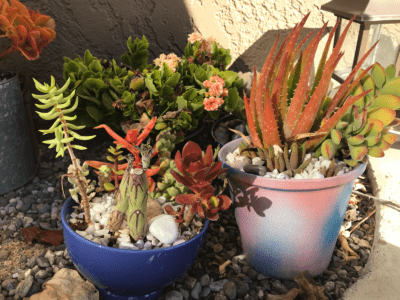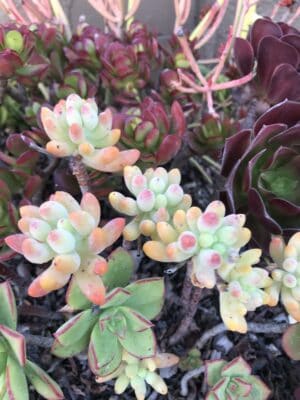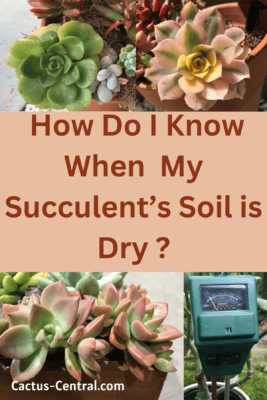This post contains affiliate links.
Succulents make great houseplants, but much like any other houseplant they require some maintenance in order to stay healthy. Knowing when to water them and how to tell when the soil is dry is part of that.
You can tell if your succulent’s soil is dry in several ways. The easiest way is to look at the color of the soil since it will look different depending on the moisture level. Another way is to do the finger test, but the most accurate way is to use a moisture meter.

So you can see that there are different ways to tell when your succulent’s soil is dry and they are all useful. Let’s talk about these ways and a few other ways in more detail.
How to Tell When my Succulent’s Soil is Dry

Your succulents are at their healthiest when you allow the soil to dry out between waterings. They can develop problems like root rot if the soil stays wet for too long.
That’s why it’s important to know whether your succulent’s soil is dry or if it still has some lingering moisture in it. Some types of succulents are affected by higher moisture levels than others too, so it is very important to know how to test for the soil’s moisture levels.
I’m listing a few methods on how to test your soil’s moisture level; some of them are low-tech and easy to do, and others are more high-tech. They all will work to one degree or another, and it’s good to know how to use them to help keep your plants healthy.
- The finger test – This is the tried and true method I usually use when testing to see if it’s time to water my plants.
Just use your finger to see if the soil is dry. You should insert your finger into the first inch or so of soil to see if it’s dry. If it is dry, then it’s time to water your plant. If you feel any moisture, it is not yet ready to be watered.
- The visual test – Look at the soil. If it is lighter in color, then it is dry. If the soil is darker, then there is still some moisture in the soil and it isn’t time to water your plant.
I believe this is the least reliable test, but it does give you a general idea of whether the soil is wet or dry. I feel this can only be done if you know through experience what your soil looks like when wet or dry. The problem is that the soil might look dry on the surface but could still have too much moisture below the surface.
- Moisture meter – This is the most accurate method of testing your soil’s moisture level. A moisture meter measures the moisture level and gives you a reading on a scale. Just stick the probe into the soil and if the reading is low, it’s time to water your plant.
If you are interested in learning more about moisture meters, we have an article explaining how a moisture meter works and another that tells you how to use one.
Amazon has many moisture meters to choose from; some of them also measure other things in addition to the moisture levels, such as the pH, or the amount of light. This one has those features, and you can check it out if you’re interested.
- Check the Weight – Another method to test how dry the soil is – is to weigh the pot(with the plant) when completely dry. Record the weight so you can compare the dry weight to the current weight. If the current weight is much more than the dry weight it still has too much moisture in the soil and is not yet dry enough to be watered.
If you use this method, you would have to periodically record the dry weight again to compensate for the growth of the plant, or if you repot your plant or add extra soil or rocks to the pot.
If you don’t have a scale to weigh your plant you can just pick it up before and after watering to get a general idea of its weight. When you pick it up, later on, to test it for dryness, if it’s lighter than usual it most likely will need to be watered.
This is a very inaccurate method of testing the soil for dryness, but some people develop a knack for knowing just when their succulents need to be watered.
- Observe the Leaves – This is really an indicator of extreme dryness and not a method to test for dryness. If your succulent’s leaves have a wrinkled appearance or appear shriveled, then it’s likely that the soil is too dry.
Underwatering your plant can cause it to lose or drop its leaves. If you want to learn more about that, Cactus-Central has an article (here) on Why Do Jade Plants Lose Their Leaves? (7 Common Reasons). This applies to other succulents too and not just Jade Plants.
If its leaves are plump and firm, then overall, the plant is getting enough water.

In Conclusion:
Monitoring the moisture levels of your succulents is a pretty important part of caring for your plants. If you use some of these methods for testing your plant’s soil, you will help ensure that they stay healthy.
Most of them aren’t really exact. But they all will help you have a better idea of how much moisture is in your plant’s soil. I believe the finger test is pretty accurate since we can “feel” the moisture using our sense of touch. I also believe weighing the plant and recording its dry weight is also pretty accurate. But I believe the most accurate test is to use a moisture meter, which you can purchase at a local garden center or even online.
For some extra information, this video talks about when to water your succulents as well as how to water them:
This post was written for cactus-central.com and is not permitted to be used on other sites.
